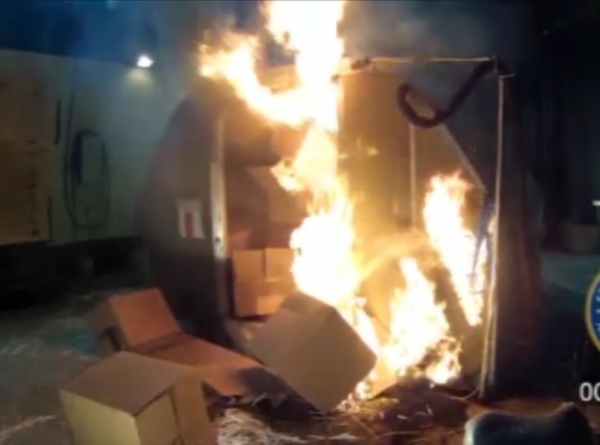United Airlines has joined Delta in banning bulk shipments of lithium-ion batteries aboard its planes.
The two major US airlines have made this decision following tests by the Federal Aviation Administration (FAA) that determined overheating batteries could cause major fires.

In its tests, the FAA filled a cargo container with 5,000 lithium-ion batteries and a cartridge heater so as to simulate a single battery overheating.
The heat from the cartridge triggered a chain reaction in other batteries, with temperatures within the container reaching 600 degrees Celsius. This was followed by an explosion, which blew open the container door, and set the cargo box on fire.

A few months later, a second test was performed. It produced similar results, despite the fact that this time around the researchers added a fire-suppression agent to the box.
“Our primary concerns when transporting dangerous goods are the safety of our customers, our customers' shipments and the environment,” United Airlines said in a statement.
The companies’ decision to ban these batteries could also be linked to some recently published reports by aviation officials that suggest lithium-ion batteries contributed to fires that destroyed several cargo planes in recent years:
In 2010, a Boeing 747 operated by United Postal Service Airlines experienced an in-flight fire and crashed in Dubai. Both crew members were killed. In the investigation that followed, the FAA pointed to the fact that a large quantity of lithium-ion batteries were aboard the plane.
In 2011, an Asiana Airlines cargo plane carrying 880 pounds of lithium-ion batteries experienced an in-flight fire before crashing into the Korea Strait. Both of its crew members were killed as well.
While the cause of this particular fire was never determined, the International Civil Aviation Organization made it a point to use the accident as reference in explaining why there should be new safety standards when carrying such batteries.
Also worth noting: Malaysia Airlines flight 370 was reported to have been carrying some 440 pounds of lithium-ion batteries in its cargo department. While the plane was never discovered, the suggestion that perhaps this bulk of batteries led to an in-flight fire followed by crash landing is one of the longer standing theories used to explain what, exactly, happened to the passenger plane.
What’s interesting about the latter story is the fact that the shipment of rechargeable batteries on passenger planes is supposed to be limited to no more than a handful in a single box; this rule was set by the UN’s International Civil Aviation Organization.
Unfortunately, though, some airlines have been exploiting a loophole with this particular rule — wherein many small boxes of these batteries can be packed into one shipment. This means thousands of batteries can be packed into pallets and loaded in to the cargo holds of passenger planes, as was the case with Malaysia Airlines flight 370.
So, for the sake of safety, Delta Airlines and United Airlines have altogether banned the shipping of lithium-ion batteries for the time being. Other airlines, like American Airlines, stopped accepting large bulk lithium-ion battery shipments, but will continue to accept small packages of batteries grouped together or packed into a single cargo container.
This decision by American has drawn criticism from industry experts, who say the company is running a high risk operation by still packing a large number of batteries into a single container, despite what the FAA has proven in its tests.
Regardless, there is now more than ever before, a tremendous focus placed on airlines to follow in the footsteps of Delta and United Airlines, and for the technology industry to figure out a safer way to transport this technology across the globe.
Via BBC
Advertisement
Learn more about Electronic Products Magazine





